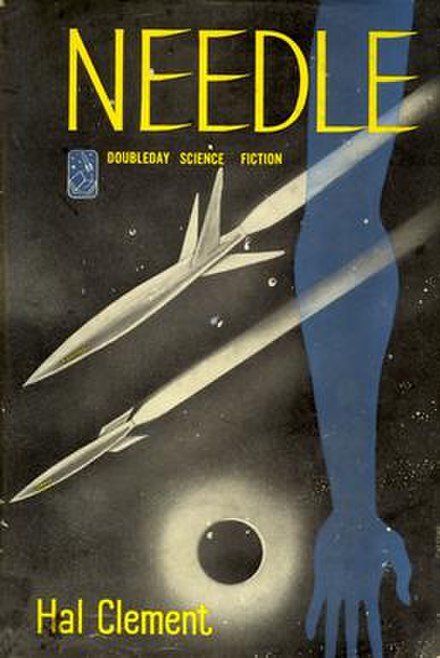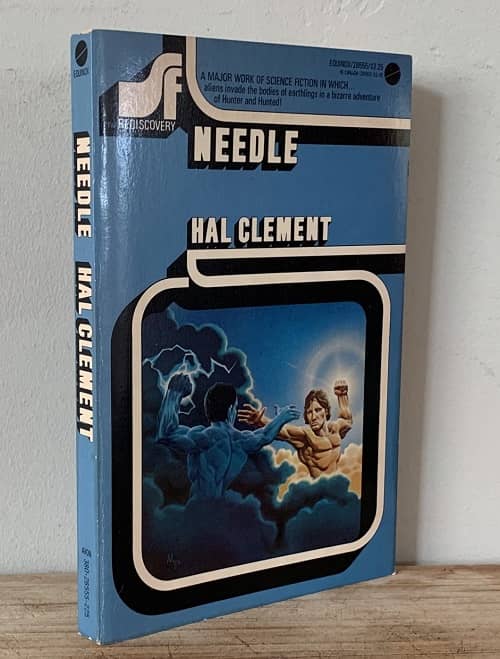But What’s at Stake? Hal Clement’s Needle
Needle (Doubleday, 1950, cover artist unknown)
Needle
by Hal Clement
(Astounding Science Fiction, May-June 1949; expanded to book form: Doubleday, 222 pages, $2.50 in hardcover, 1950)
Hal Clement (legal name Harry Stubbs) was one of the stable of science fiction writers developed by John W. Campbell in the pages of Astounding magazine in the 1940s. His first story was “Proof” in the June 1942 issue and his next 10 stories appeared in the magazine throughout the ‘40s. He’s most famous for the 1954 novel Mission of Gravity and his reputation rests on its sort of hard science fiction: alien environments rigorously extrapolated from known physical principles. (Others in this vein were Iceworld, 1953, and Cycle of Fire, 1957.)
His first novel is a little different. This is Needle, serialized in Astounding and expanded to book form the following year for Doubleday. And published, incidentally, as a juvenile, in the “Doubleday Young Moderns” series, despite, as SFE notes, certain themes. (The edition I’m reading, and using pagination from, is a 1974 trade paperback reprint in Avon/Equinox’s SF Rediscovery series, with an odd cover illustration depicting two Greek-like gods fighting in the clouds. Photo below.)
[Click the images for Astounding-sized versions.]
Needle (Equinox/Avon SF Rediscovery #20, 1976, cover by Mike Presley)
Gist
The premise is that a good guy alien, Hunter, is pursuing across space a bad guy alien, Killer, and they both emerge from FTL in their separate ships near Earth and crash into the ocean just offshore of an island near Tahiti. The aliens are symbionts and must inhabit other bodies to survive. Hunter occupies a 15-year-old boy lying on the beach, makes himself aware to the boy, and together they engage on a detective hunt to identify what other person, on this small island, is harboring the fugitive Killer. It’s like searching for a needle in a haystack — except that the needle is disguised as a piece of hay.
Take
This is a decent mystery/detective story, in that a quarry must be found, various likely candidate hosts are identified, and circumstances eliminate some or suggest others, until the resolution uses clues we likely haven’t noticed to identify a previously unsuspected suspect. The greatest flaw is that the stakes are arbitrary — the bad guy is bad because we’re told so — while apparently the symbionts are if anything beneficial to their hosts, not harmful. What would have happened if the quarry hadn’t been found? Nothing at all, apparently. It’s a matter of alien justice, only.
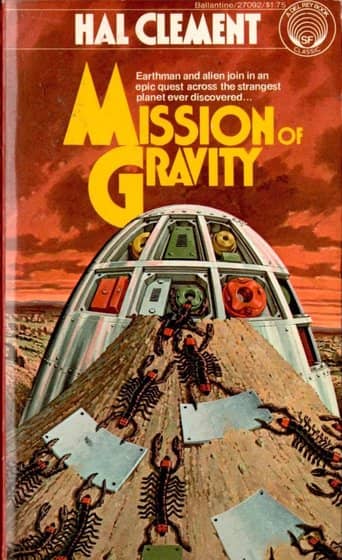 |
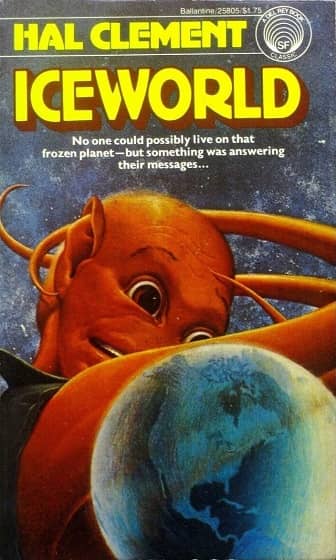 |
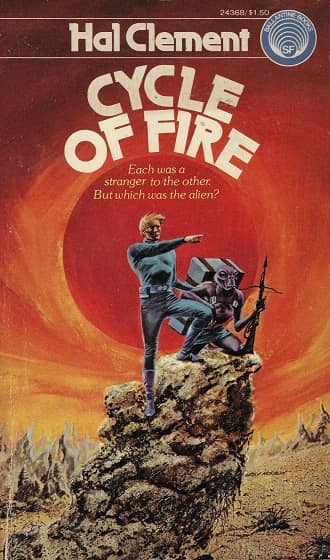 |
Mission of Gravity (Del Rey, 1978, cover by H. R. Van Dongen), Iceworld (Del Rey, 1977, H. R. Van Dongen),
and Cycle of Fire (Ballantine, 1975, Gray Morrow).
Summary and Comments
- The opening pages describe Hunter and his ship, emerging from FTL and crashing into a planet into shallow water. The ship is just 20 inches by 2 ft (our omniscient author informs us), and Hunter weights just 4 pounds. He has a companion animal called a “perit” which has not survived. (And nothing much is made of what this companion did; perhaps serve as a surrogate host during space travel.) We’re told how Hunter is a metazoan but with extremely small cells; it can reshape itself, e.g. exuding pseudopods, and insinuate itself into other creatures, like a passing shark, which Hunter then kills by depriving it of oxygen.
- The dead shark washes up on the beach. Hunter observes bipeds approach and play in the water. Hunter disguises himself as a jellyfish to approach them…
- Up to this point the narrative does a decent job in describing things from an alien point of view, including some things we recognize as ordinary parts of our world that the alien doesn’t quite understand. (There’s a subgenre of such stories – Asimov’s “Green Patches” comes to mind — of SF writers doing this for better or worse.) But at this point the author gives up and tells us…
- One of the boys is Robert Kinnaird, 15-years-old, and his friends are having a farewell picnic; summer is ending and Robert is heading back to school on the mainland. As the boys sleep on the beach, Hunter creeps across the sand and enters the boy’s foot, moving through his muscles and organs, settling in the abdomen. He reminds himself of his kind’s ancient law: Do nothing that can harm your host!
- The prose is rather clinical, e.g. page 22 as the boys part: “They were rather silent now, with the awkwardness natural to their ages when faced by a situation which adults would treat either emotionally or with studied casualness.” And throughout, Clement is fond of semicolons. And it’s third-person omniscient; note how the author informs us of the thoughts of both the doctor and the father, on pp56-57.
- We get some background on Hunter’s race, a race of symbionts that typically live on good, open terms with their hosts. A minority who occupy hosts covertly are regarded as evil and must be terminated — like Hunter’s quarry.
- Robert returns to school in Massachusetts, and Hunter is inadvertently carried along, panicked that his quarry is now far behind him. Months pass. Hunter learns the boy’s language by observing his physics class.
- Typically of SF stories of this era, aliens are given the task of learning the humans’ language, rather than vice versa, and do so with remarkable speed (necessary to plot); Clement at least allows this to happen over a period of months.
- Hunter decides to reveal himself to Robert, which he does by taking control of the boy’s hands, then eyes, eventually projecting words across Robert’s field of vision
- Robert is initially freaked out by feeling his fingers twitch, and so on, but once communication begins, accepts with remarkable equanimity that an alien creature has secreted itself inside his body. SFE’s Clement entry notes that “This internal symbiosis is a highly loaded theme” but that the story is “told without any of the necessary queasy resonance.” My thought in particular was how an adolescent, especially, might feel angst about some alien, or anyone, witnessing all his bodily functions.
- Robert also discovers a useful function of his symbiont. In his initial panic he races down the stairs and cuts open his arm, and sees that Hunter has the ability to seal the cut by extruding some glistening substance onto his skin. This puzzles the school nurse! A couple of times later in the book Hunter similarly rescues Bob from serious injury.
- Robert (Bob) learns to speak out loud to communicate with Hunter. He quickly appreciates Hunter’s situation, and thus the need to return to the island, without any excuse to leave school to do so. In a convenient yet plausible bit of plotting, Bob’s distraction from his schoolwork on this matter leads to his dismissal from school for a rest leave back home.
- And so Bob (and Hunter) return to his island. At this point we’re at page 61 of a 207 page novel. The bulk of the book consists of…
- Hunter trying to identify just where offshore the alien ships crashed, and therefore which humans might have been occupied by the quarry.
- Bob meeting up with friends Kenny, Norman, Hugh, and Kenneth. They spend much time swimming, and exploring the southern edge of the island behind the reef. Bob can’t help but think these friends, on the beach with him that day, are the most likely hosts for Killer.
- Meanwhile, Bob’s father is busy with a large construction project; the island’s economy rests on creating petroleum products from local plants.
- Bob confides to the local doctor — who, as was Bob, is remarkably unperturbed by the idea of an alien symbiont. (It’s as if he was officer on some Trek starship, told of an incredible circumstance, accepting it immediately, and dealing with it, because that’s his job. To be fair, Hunter has Bob and the doctor hold hands for 20 minutes to establish contact between the doctor and the alien.)
- And all of this happens over the space of two or three days, because one of the prime suspects of hosting Killer is about to leave the island, and because Bob, who’s arrived on a Friday, is due to attend the local school on Monday.
- One by one Bob’s friends seem to be ruled out; they’ve acted in ways a symbiont would not let them. Who is left?
- Bob doesn’t figure it out; his symbiont Hunter does. It’s…. SPOILER … Bob’s father. Hunter verifies this by emerging from Bob’s body in the middle of the night and oozes into the sleeping Mr. Kinnaird’s room, and makes contact with Killer, in a stand-off.
- Hunter explains his reasoning to Bob the next morning: he’s observed Mr K. becoming more and more careless over the past few days, with several examples cited from scenes we’ve witnessed on the dock and at the construction site and perhaps not paid close enough attention to.
- The rationale is that Killer, inside Mr. K’s body, has been protecting him from casual injuries just as Hunter has Bob, and this has made Mr. K less careful as he moves about the docks and the work site.
- I don’t think this is plausible – if I cut myself and it healed amazing fast, would I become more careless around knives assuming I would heal quickly again? And did Hunter really notice this trend over the space of two or three days?
- Stalemate? The climax comes as Bob arranges an elaborate stunt, which involves setting a fire that threatens an explosion, to apparently threaten both himself and his father. The reasoning is that the Killer will flee Mr. K’s body if there’s risk to itself.
- The scheme works and Bob douses the Killer’s bloblike body to kill it.
- The Asimovian chapter titles (including “Signal,” “Answer,” “Stage…”, “Setting…” and “Players”, and especially “Slip!” and “And Fall!”) helpfully mark key points of plot. “Problem One” was identifying Killer’s host. “Problem Two” was ridding the host of Killer. The final chapter is called “Problem Three”. What would this problem be? Why, fairly obviously, it’s what does Hunter do now? He has no way of leaving Earth to return to his own world. That’s obvious, so perhaps the actual problem is whether Bob is willing to continue hosting him. And without a moment’s hesitation, Bob agrees, and he needs Hunter to concoct an explanation for why he started that fire. The end.
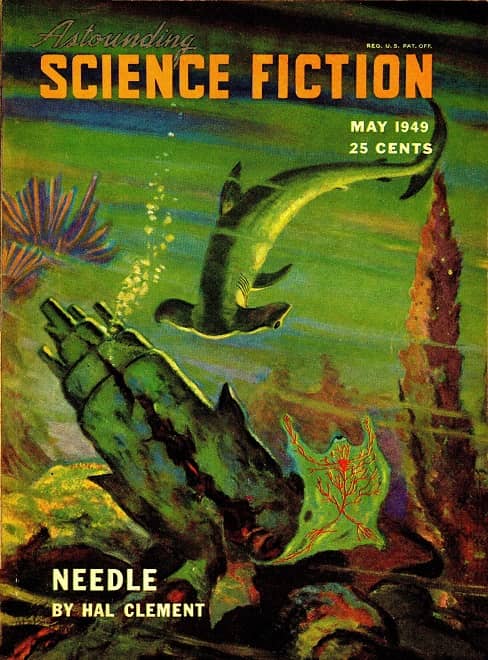 |
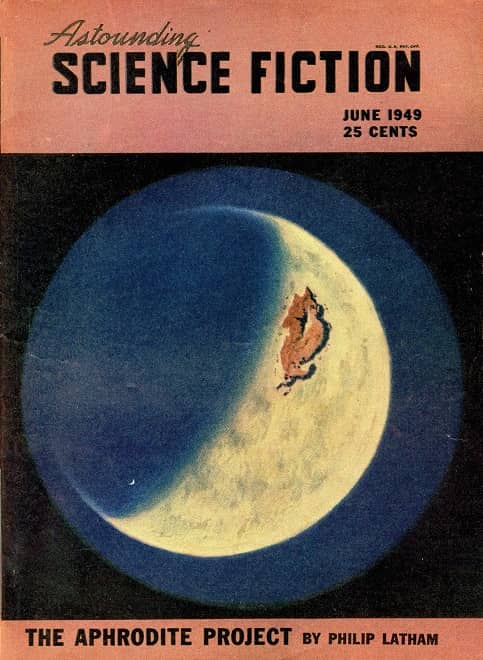 |
Astounding Science Fiction, serializing Needle: May 1949 (cover by Paul Orban)
and June 1949 (cover by Chesley Bonestell). Click for bigger images.
Notes
I was reminded somewhere recently that one way of thinking about a story is to consider, what are the stakes? Why should we care? And so my problem with this story is why there is such urgency to find Killer and remove it from its host. We gather that Mr. Kinnaird was never aware of hosting an alien; nor have we been given any reason to think the alien Killer has been manipulating the human to carry off some evil plan. We haven’t even been told that Killer at any time killed anyone; his name begs his evil status. (Or did I miss something?) What was the problem with both Hunter and Killer remaining in their hosts? If anything, these symbionts are beneficial to their hosts, in that they can protect their hosts from bodily injury.
Credit given for Bob’s having the presence of mind to wonder if Hunter is telling him the truth about who he and his quarry are. Mightn’t Killer tell Mr. K an identical story, or some cover story to justify his presence? Yet, though we suspect once or twice that Mr K is aware of, or being manipulated by, his symbiont, we gather by the end of the book that he was entirely unaware of his invader. (I noted a line on page 127, which I thought might be foreshadowing, as Mr. K observes his son Bob napping: “Mr. Kinnaird approached silently and looked down at the boy for some time with an expression that defied interpretation.” Perhaps this is just haphazard omniscient narrative from Clement.)
Much is made of Bob’s not having opportunities to speak with Hunter, since doing so requires talking out loud — but all he has to do is go to the bathroom. Except characters in fiction of this era didn’t go to the bathroom.
The endless details about the geography of the island, how the boys move back and forth across it, get wearying. You have the impression the author lived on such an island and is using it exactly as the model for the nameless island in this book. (Though the bios at SFE and Wikipedia indicate no such connection; Clement spent WWII in Europe.) And the author also seems to know a lot about industrial construction!
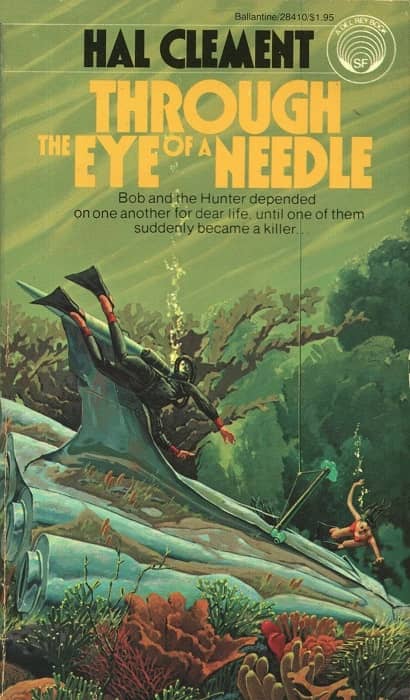 |
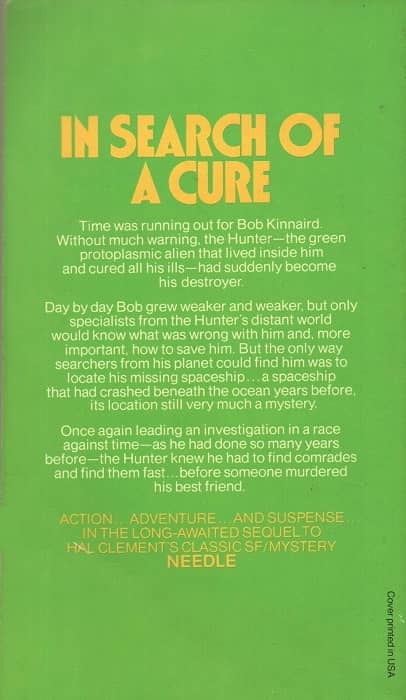 |
Through the Eye of the Needle (Del Rey, 1978, cover by H. R. Van Dongen).
I should note that Clement wrote a sequel years later, Through the Eye of a Needle (1978), which I’ve not read. So perhaps he addressed some of these lingering issues there.
Conclusion
Despite a couple gaps in plausibility, this is a good example of Campbellian era problem-solving science fiction. Situations are set up, and problems are introduced that must be solved within the constraints of the situations. How does Hunter establish contact with the human he is occupying? How do they find who’s hosting Hunter’s quarry, with no way to tell externally, only by circumstance? This is the kind of story that invites the reader to solve these problems before the characters do, as in any good mystery novel.
Mark R. Kelly’s last review for us was Earth Abides by George R. Stewart. Mark wrote short fiction reviews for Locus Magazine from 1987 to 2001, and is the founder of the Locus Online website, for which he won a Hugo Award in 2002. He established the Science Fiction Awards Database at sfadb.com. He is a retired aerospace software engineer who’s lived almost his entire life in Southern California. Find more of his thoughts at Views from Crestmont Drive.
